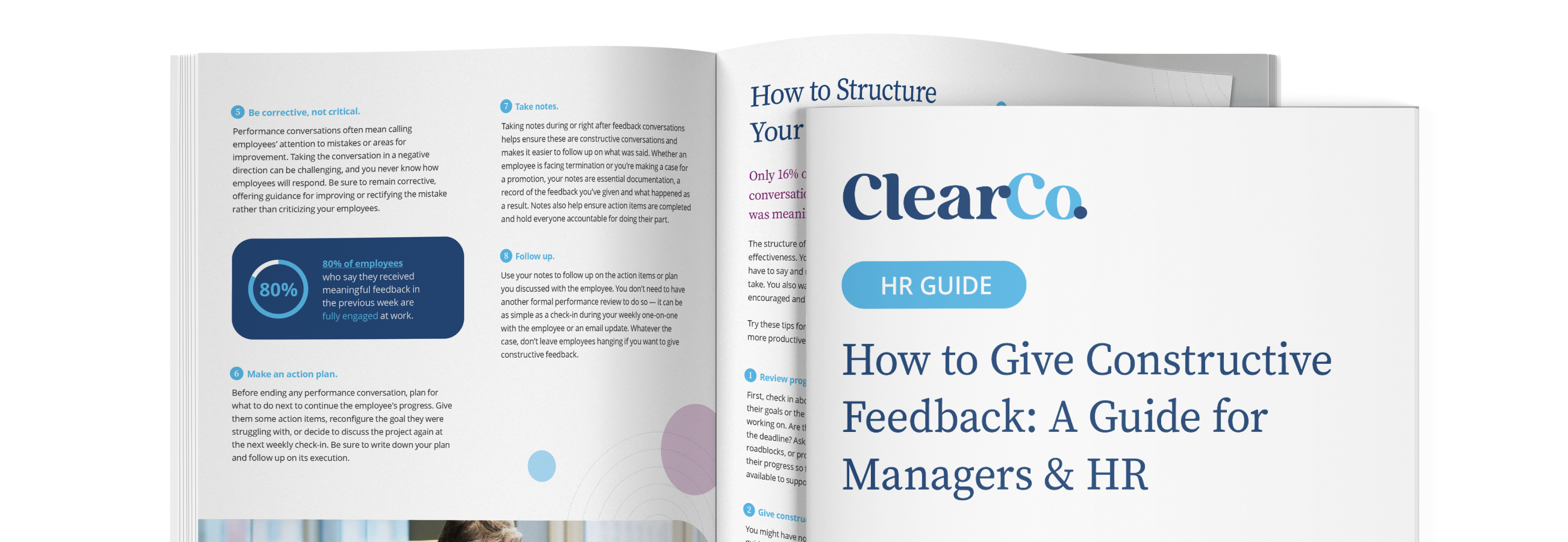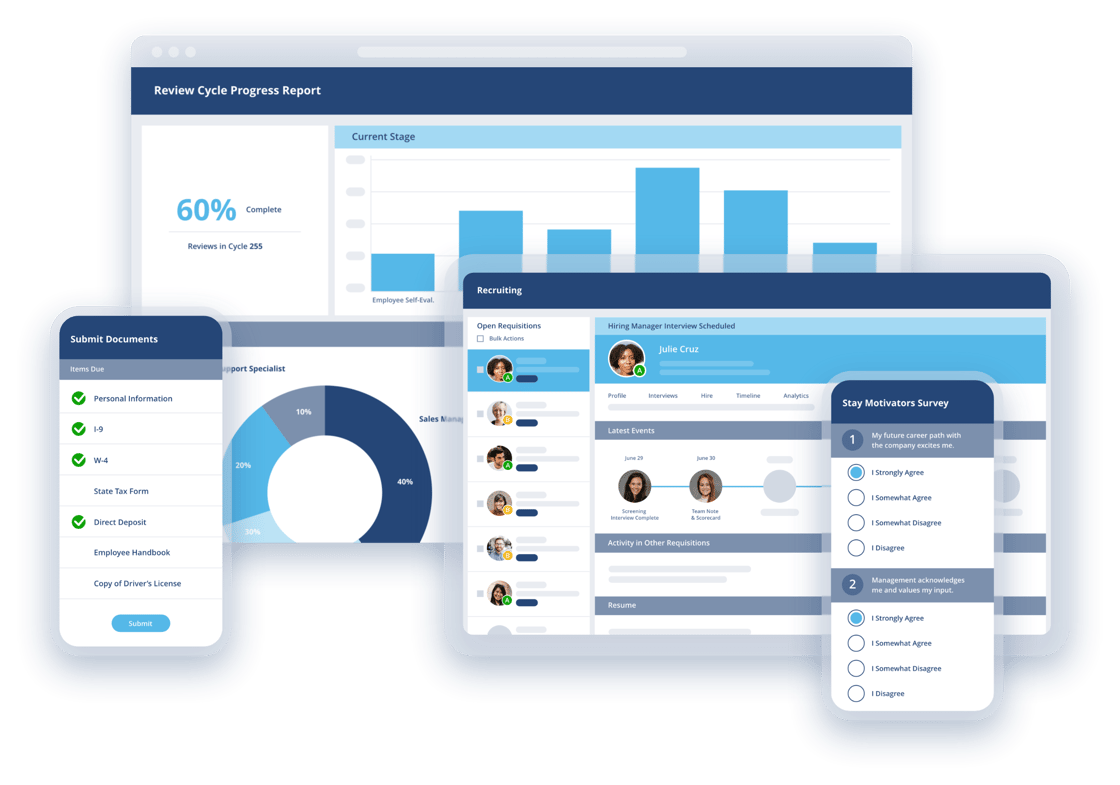Giving feedback to any of your employees can be daunting, but when it comes to high performers, things can get a little more complex. You don’t want to stand over their shoulder and micromanage their every move, but you don’t want to ignore them, either. Although it may be tempting to focus more on employees who need more help, high performers need constructive feedback, too. They need support and direction not just to avoid burnout and disengagement, but so they can grow their skills even further.
So, how do you strike the right balance between giving constructive feedback, offering support, and letting your high performers do what they do best?
If you’ve ever felt unsure how to best support your high performers’ professional development, you’re not alone. 70% of managers say they’re not comfortable giving feedback, and 68% of employees say their managers aren't actively engaged in developing their professional skills. Clearly, there’s lots of room for improvement for managers when it comes to offering praise and pointers —and we’ve got the help you need.
Keep reading for three tips to help you strike the right balance between motivating high performers with positive feedback and coaching them toward further professional growth.
1. Give Feedback All Year Long
The standard once-a-year review doesn’t provide enough feedback for any employee, let alone high performers. Research time and again tells us that employees want more feedback, even if it’s not positive —72% say constructive criticism is vital for their career growth. If your high performers don’t know how they’re doing at work and aren’t sure how to progress, it’s far more likely they’ll become disengaged and quit.
Finding ways to provide consistent feedback will help you increase retention and give you a competitive advantage in your recruiting efforts. Your goal is always to retain top talent, so check-ins with high performers should be frequent, taking place at least weekly. 80% of employees who said they received meaningful feedback in the previous week were fully engaged.
Delivering feedback in a timely manner is essential so that your high performers can apply it to their work right away. Waiting weeks or months to offer constructive feedback may even frustrate top talent, making them feel like they missed a chance to improve. The need for more feedback is only growing as Millennials and Gen Z begin to make up a majority of the workforce.
Engagement among these generational groups has dropped significantly since 2020, from 39% to 32% among Millennials and from 40% to 32% among Gen Z. According to Gallup research, areas of engagement that have suffered the most indicate that these declines are largely due to a lack of connection. Among the two youngest generations of workers, fewer reported:
- Feeling cared about by someone at work
- Having opportunities to develop, learn, and grow
- Feeling connected to their company’s mission
- Discussing their progress with managers
- Feeling that their opinions count
You’re well aware that when engagement is down, retention takes a hit, putting you at greater risk of losing these valuable employees —especially high performers. It’s essential that HR leaders find ways to attract and retain these employees in order to stay competitive.
Fortunately, you can address all of these factors of engagement with weekly check-ins and an increase in feedback frequency. When you’re meeting with Millennial and Gen Z employees who consistently deliver, those one-on-ones become opportunities to build relationships, provide support and resources, and get your direct reports’ feedback. Instead of looking for areas for improvement, you can discuss areas for growth and set goals for role development.
Feedback sessions don’t always need to happen face-to-face to be effective, especially when so many of our work environments are remote or hybrid. You can share quick, straightforward feedback via email or instant message, or in a reply to an employee’s goal update or shared notes. That has the added benefit of putting your feedback “on the record.”
Get ClearCompany’s in-depth Guide to Giving Constructive Feedback to learn how to give actionable, useful advice that helps your people reach their full potential.
2. Get Specific
Specificity is a good rule of thumb when you’re giving feedback to any employee, but this goes double for high performers. They may be used to not getting much feedback beyond a generic “Good job!” —if they get any at all. But that doesn’t help improve their work abilities or professional skills.
Feedback Tip: 360-degree feedback gives employee performance more context and perspective by including self-assessments and peer reviews in their formal review process. Consider implementing 360 feedback to get a more complete view of workforce performance and gain insight into overlooked high performers.
Be specific so you clearly communicate what you see your employees doing well. Imagine you tell a high performer, “Great work on the presentation last week!” They might assume you’re referring to the sleek slide deck they prepared, but you were actually referring to their extensive knowledge of the topic. Their slides were a great supplement, but the real star was the high performer’s enthusiasm and expertise.
Imagine that instead, you said, “Great work on the presentation last week! The leadership team was so impressed that you could answer all of their questions on the fly and strategize with them in real time. You’re clearly excited about this project, so let’s explore more ways for you to contribute.” This is motivating, clearly communicates the employee’s strengths, and tells them how you’re going to support their growth.
3. Look for Learning Opportunities
Performance management statistics show that 94% of employees said they would stay at a job longer if they had access to professional development or career growth opportunities. Finding ways to implement learning and development opportunities in your workplace will be essential for retaining your high-performers.
Feedback Tip: Read our post with even more advice on how to give feedback that employees actually want. Whether it’s being specific about how they can improve, giving them the space to ask questions, or motivating them to do their best, boost your leadership skills when you apply these tips for giving effective feedback.
Luckily, increasing the frequency and specificity of your feedback means you’ll get to know your high performers much better —and will be far more tuned into their career goals. You’ll have a better understanding of the strengths they have refined and the skills they want to grow. You can then work closely with them to find the best ways to maintain their strengths and grow their skills.
Develop tailored career paths and set professional goals that ensure their continued growth and help increase their loyalty to your company. Continue the ongoing feedback loop by discussing their career growth progress during your weekly one-on-one meetings.
9 Phrases for Giving Productive Feedback
Frequent feedback encourages your top talent to keep up the great work and is an excellent retention tool. But it can be a challenge to give positive feedback that’s also helpful or negative feedback that isn’t perceived as a personal attack. You want to make your point and give words of advice or explain exactly why the employee exceeded expectations.
If you’re having trouble finding the right words to give high performers feedback, we've collected some phrases you can use to share your thoughts and questions to help you ask for theirs. Using these templates, add in the details about your high performers:
- Thank you for your work on [project]! Your strengths shined most when you [specific actions].
- You and I meet [meeting frequency]. Does the current schedule work for you, or would you like to meet more or less often?
- You did a great job with [project or task]. What was your process for reaching this achievement, and did you have any issues or roadblocks?
- You excel at [strength]. Let’s work on developing that strength in the next year by [specific actions].
- Your presentation on [topic] was excellent. What aspects of the presentation do you feel went particularly well, and why?
- You’ve demonstrated exceptional skills in [area]. How do you think we can leverage this strength in upcoming projects?
- Your problem-solving skills in [specific situation] were outstanding. What techniques did you use, and how can we apply them to other projects, tasks, or situations?
- I’ve noticed your growth in [specific area]. What resources or support do you think could help you continue this development?
- You consistently deliver high-quality work. What motivates you, and how can we ensure you continue to feel challenged and engaged?
High-performing employees are your company’s greatest asset, so it’s important to give them timely, specific, and actionable feedback and support their professional development. That’s the proven formula for increasing engagement — and companies with engaged employees see increased productivity, greater customer loyalty, and higher annual revenue. Focus on the specifics and get their feedback to help high performers perfect their skills, rise to new challenges, and stay engaged.
Performance Management Software With Frequent Feedback Features
You can execute a continuous feedback strategy and give more actionable feedback with the right software.
ClearCompany Performance Management is fitted with all the tools you need to make giving —and receiving — feedback a regular part of daily operations:
- 1:1 Workspaces provide a private space for managers and employees to communicate about goals and progress. You can schedule recurring meetings, take and share notes, record action items, set and update goals, and more. ClearCompany creates an accessible digital record you can reference during reviews and to make the case for increased resources and promotions.
- Performance review templates and customizable reviews simplify the process, making it easy to track employees’ progress and create a record throughout their tenure. These records are excellent for high performers who want to move up the ladder.
- Celebrations send automatic notifications about birthdays and work anniversaries, making it easy to appreciate your people on their big days.
- The Shout Outs feature gives every employee a chance to “shout out” their team members for a job well done. These notes of appreciation are automatically attached to employee profiles so they’re readily available during performance evaluations.
- As you gather performance data and feedback, you create detailed portraits of what makes a high-performing employee. With ClearCompany’s detailed reporting and analytics, you can leverage performance data to better understand how to engage, motivate, and retain them.
Our fully customizable software allows your organization to choose the feedback approach that works best for your people and processes. In addition, with our integration capabilities, you can rest assured that you can seamlessly connect ClearCompany to your current technology and tools.
For more information about how ClearCompany will help to enhance the quality of feedback you provide to your high-performers, reach out to one of our experts and schedule your free demo now.



